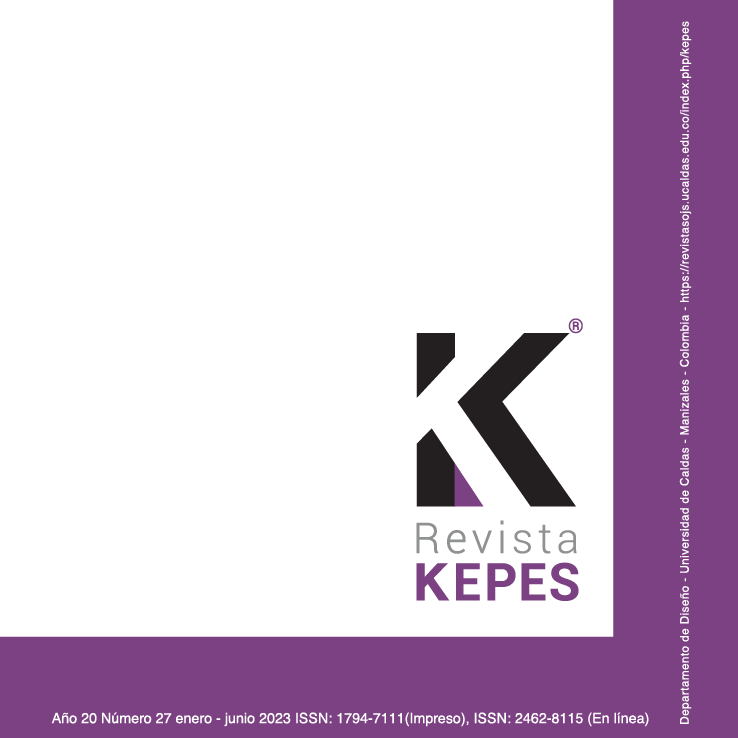Authors
Abstract
Cartographies are constituted as a graphic representation of the inhabited space that provokes reflections on the social, cultural, and political subject. Stressed with the new narrative methods that involve interactivity, interaction, immersion, and the audiovisual, cartographies can enhance the learning-teaching processes involved in carrying them out. For this reason, this research + creation proposed the construction of an interactive device at scale: expanded cartography for the representation and dissemination of urban perceptions, memories, and images about the city center of Armenia turning it into a pedagogical tool that allows the non-specialized participant to read and create cartographic images and understand their link with social practices. As a research process, it was supported in different methods and protocols for the readings of the realities that give rise to creation. Participatory techniques were articulated: social cartography to ensure that passers-by and guests are co-authors of it, activating a shared space where experiences converged; collective sensitive knowledge was built, and links were generated between participants and with the final creation. It was found that public and open urban spaces are the ones that generate the highest number of perceptions and associated memories. Their condition of greater accessibility, diversity of activities in their interior, physical-formal structure designed for permanence, their articulation to the mobility of the city and the interest they arouse in terms of urban services, make them accumulate memories, experiences, and feelings by a larger number of people. Social cartography is presented as an emancipatory visuality where the subject, based on his urban experience, builds his own images on his spatial realities.
Keywords:
References
Barragán-León, A. N. (2019). Cartografía social: lenguaje creativo para la investigación cualitativa. Sociedad y Economía, 36, 139-159. https://doi.org/10.25100/sye.v0i36.7457
Betancurth, D. P., Vélez, C. y Sánchez, N. (2020). Cartografía social: construyendo territorio a partir de los activos comunitarios en salud. Entramado, 16(1), 138-151. https://doi.org/10.18041/1900-3803/entramado.1.6081
Beuf, A. (2020). Centralidad y policentralidad urbanas: interpretaciones, teorías, experiencias. Espiral, Revista de Geografías y Ciencias Sociales, 1(2), 131-155. https://doi.org/10.15381/espiral.v1i2.17135
Black, P. y Street, E. (2014). The Power of Perceptions: Exploring the Role of Urban Design in Cycling Behaviours and Healthy Ageing. Transportation Research Procedia, 4, 68-79. https://doi.org/10.1016/j.trpro.2014.11.006
Borja, J. y Muxí, Z. (2001). Centros y espacios públicos como oportunidades. Perfiles Latinoamericanos, 9(19), 115-130. https://perfilesla.flacso.edu.mx/index.php/perfilesla/article/view/318
Casimiro, G. y Medeiros, M. (2016). Cartografias expandidas: Realidade Aumentada e a exposição Memória da Amnésia. XX Congreso de la Sociedad Ibero-americana de Gráfica Digital (pp. 880-884). http://papers.cumincad.org/cgi-bin/works/paper/sigradi2016_639
Cheshmehzangi, A. y Heat, T. (2012). Urban Identities: Influences on Socio-Environmental Values and Spatial Inter-Relations. Procedia - Social and Behavioral Sciences, 36, 253-264. https://doi.org/10.1016/j.sbspro.2012.03.028
Filipe, C. A. y Ramírez, B. R. (2016). Discursos, política y poder: el espacio público en cuestión. Territorios, 18(35), 37-57. https://doi.org/10.12804/territ35.2016.02
Folch, R. y Bru, J. (2017). Ambiente, territorio y paisaje - Valores y valoraciones. Editorial Barcino y Fundación AQUAE.
https://www.fundacionaquae.org/wp-content/uploads/2017/12/AMBIENTE-TERRITORIO-Y-PAISAJE.pdf
Galvis, Y. y Mejía, A. (2019). Corporalidad en la interacción e interactividad comunicativa: estudio de caso en la sala Mente, el mundo adentro del Parque Explora. Revista Kepes, 16(19), 427-463. https://doi.org/10.17151/kepes.2019.16.19.16
Giménez, G. (2009). Memoria, relatos e identidades urbanas. Versión (México, D.F.), 23, 197-209. https://versionojs.xoc.uam.mx/index.php/version/article/view/366/365
Lefebvre, H. (2013). La producción del espacio. Capitán Swing Libros, S. L.
Lindón, A. (2002). La construcción social del territorio y los modo de vida en la periferia metropolitana. Territorios, 7, 27-41. https://revistas.urosario.edu.co/index.php/territorios/article/view/5680
Llanos-Hernández, L. (2010). Concepto de territorio y las investigaciones en las ciencias sociales. Agricultura, sociedad y desarrollo, 7(3), 207-220. http://www.scielo.org.mx/scielo.php?script=sci_arttext&pid=S1870-54722010000300001
Lois, C. y Hollman, V. (2013). Introducción. En C. Lois y V. Hollman (Eds.), Geografía y cultura visual. Los usos de las imágenes en las reflexiones sobre el espacio (pp. 15-25). Prohistoria ediciones y Universidad Nacional de Rosario.
López, J. A. (2019). Visualidad y diseño de comunicación visual, relación cartografías mentalesentorno en la definición de variables de diseño de comunicación visual. Revista Kepes, 16(19), 277-293. DOI: 10.17151/kepes.2019.16.19.11
Mannay, D. (2017). Métodos visuales, narrativos y creativos en investigación cualitativa. Narcea, S. A. de ediciones.
Moreno, G. E., Rojas, L. P., Fagua, A. P., Sanabria, H., Sanabria, M. y Rey, N. (2015). Subjetividades y territorialidades: una aproximación desde la cartografía social en el contexto colombiano. Psicogente, 18(33), 206-225. https://doi.org/10.17081/psico.18.33.66
Othman, S., Nishimura, Y. y Kubota, A. (2013). Memory Association in Place Making: A review. Procedia - Social and Behavioral Sciences, 85, 554-563. https://doi.org/10.1016/j.sbspro.2013.08.384
Pallasmaa, J. (2014). Los ojos de la piel: la arquitectura y los sentidos (2a. ed.). Editorial Gustavo Gili.
Pelli, M. B. (2020). Las fronteras del habitar en el espacio urbano. Prácticas de apropiación. Bitácora Urbano Territorial, 30(1), 103-114. https://doi.org/10.15446/bitacora.v30n1.70106
Ramírez, P. (2015). Espacio público, ¿espacio de todos? Reflexiones desde la ciudad de México. Revista Mexicana de Sociología, 77(1), 7-36. https://www.scielo.org.mx/pdf/rms/v77n1/v77n1a1.pdf
Ricart, N. y Remesar, A. (2013). Reflexiones sobre el espacio público. On the w@terfront, 25, 5-35. https://www.raco.cat/index.php/Waterfront/article/view/263776
Risler, J. y Ares, P. (2013). Manual de mapeo colectivo: recursos cartográficos críticos para procesos territoriales de creación colaborativa. Tinta Limón. https://iconoclasistas.net/4322-2/
Silva, A. (2006). Imaginarios urbanos (5a. Ed.). Arango Editores.
Silva-Cañaveral, S. J. (2016). La investigación-creación en el contexto de la formación doctoral en diseño y creación en Colombia. Revista de Investigación, Desarrollo e Innovación, 7(1), 49-61. https://doi.org/10.19053/20278306.v7.n1.2016.5601
Stocchetti, M. (2017). Digital visuality and social representation. Research notes on the visual construction of meaning. Kome - An International Journal of Pure Communication Inquiry, 5(2), 38-56. https://doi.org/10.17646/KOME.2017.23
Vanolo, A. (2008). Urban Images and the Creative City. Language and the Scientific Imagination: The 11th International Conference of ISSEI (pp. 1-19). https://helda.helsinki.fi/bitstream/handle/10138/15244/60_Vanolo.pdf?sequence=1

 PDF (Español)
PDF (Español)
 FLIP
FLIP
 Perfil Google Scholar
Perfil Google Scholar


















